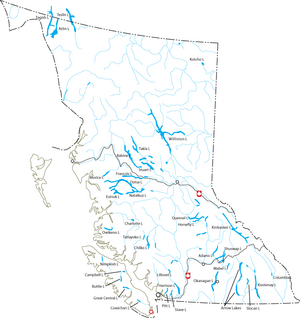Cheslatta Lake facts for kids
Quick facts for kids Cheslatta Lake |
|
|---|---|
| Location | British Columbia |
| Coordinates | 53°44′N 125°21′W / 53.733°N 125.350°W |
| Primary inflows | Cheslatta River |
| Basin countries | Canada |
| Surface area | 35.0 km2 (13.5 sq mi) |
Cheslatta Lake is a large freshwater lake in British Columbia, Canada. It is located between François Lake and the western part of the Nechako Reservoir. This lake is found in the Regional District of Bulkley-Nechako.
What's in a Name? The Story of Cheslatta Lake
The name Cheslatta comes from the Dakelh (also known as Carrier people) language. It means either 'top of small mountain' or 'small rock mountain on east side'.
Over the years, the spelling of the lake's name has changed a few times on maps:
- In 1871, it was called "Chestatta" Lake.
- By 1884, it changed to "Cheslahta".
- In 1891, it appeared as "Cheslata" Lake.
- Finally, on March 30, 1917, the name "Cheslatta Lake" was officially adopted. This was based on older maps from 1895 and 1916.
Life in the Lake: A Healthy Ecosystem
Before the Kenney Dam was built, Cheslatta Lake and the nearby Murray Lake were full of life. Their ecosystems were very productive, meaning they had many different kinds of plants and animals. This included lots of fish!
For hundreds of years, First Nations people used these lakes as important fishing grounds. This shows how healthy and rich in fish the lakes were.
How the Kenney Dam Changed Cheslatta Lake
In the 1950s, the Kenny Dam was built on the Nechako River. This dam changed the natural flow of water. Instead of flowing east, water was sent westward to create electricity for a company called Alcan.
These changes had a big impact on the area around Cheslatta Lake:
- The Cheslatta Carrier Nation village and cemetery were flooded.
- The First Nations people had to move quickly, with little time to prepare. They were not asked for their input.
- Before 1957, the Cheslatta River was a small stream.
- After the dam, Alcan released much more water than the river could handle.
- This extra water carved a deep channel and caused a lot of erosion. Soil, gravel, and plants were washed into the Cheslatta and Nechako Rivers.
- The area between Skins Lake and Cheslatta Lake, which used to be meadows and small lakes, was scoured clean by the powerful water.
These changes also affected the fish in Cheslatta Lake. There has been a big drop in the number of kokanee salmon and other fish that live in the open water of the lake.



